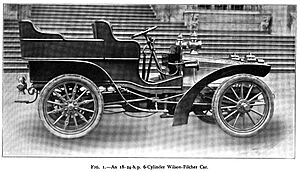Walter Gordon Wilson facts for kids
Walter Gordon Wilson was an Irish engineer and inventor. He was born on April 21, 1874, and passed away on July 1, 1957. He is best known for helping to invent the tank during World War I. The Royal Commission on Awards to Inventors officially recognized him as a co-inventor of the tank, along with Sir William Tritton. Wilson was also a member of the British Royal Naval Air Service.
Contents
Early Life and Education
Walter Wilson was born in Blackrock, County Dublin, Ireland, on April 21, 1874. When he was 14, in 1888, he joined the navy as a midshipman on HMS Britannia. However, he left the navy in 1892.
In 1894, he went to King's College, Cambridge. There, he studied mechanical engineering. He graduated in 1897 with a top degree. While at Cambridge, Wilson often helped C. S. Rolls (who later co-founded Rolls-Royce cars) with mechanical projects.
Designing an Aero Engine (1898)
Wilson was very interested in powered flight. In 1898, he teamed up with Percy Sinclair Pilcher to try and build an aero-engine. Their engine was a "flat-twin" design, meaning it had two cylinders that lay flat. It was air-cooled and weighed only 40 pounds.
They planned a demonstration flight for September 30, 1899. Sadly, just before the flight, the engine's crankshaft broke. Not wanting to disappoint his supporters, Pilcher decided to show off a glider instead. The glider crashed, and Pilcher was badly hurt. He died from his injuries at just 33 years old. Pilcher's death was a big shock for Wilson. He stopped working on aero engines, but he later used the "flat-twin" engine idea in cars he built. He named these cars Wilson-Pilcher.
The Wilson-Pilcher Car (1900)
After Percy Pilcher's death, Wilson started building motor cars. He launched the Wilson-Pilcher car in 1900. This car was quite special for its time. It could have either a flat-four or a flat-six engine. These engines were very balanced and gave the car a low center of gravity, making it stable.
Each cylinder was separate and water-cooled. They were the same for both engine types. The car's gearbox was also new. It had special epicyclic gears and was directly attached to the engine. This allowed for four speeds and made the car very quiet.
In 1904, after he got married, Wilson joined Armstrong Whitworth. This company took over making the Wilson-Pilcher car. From 1908 to 1914, he worked with J & E Hall. He helped design the Hallford lorry, a type of truck. These trucks were used a lot by the army during World War I.
Today, only one Wilson-Pilcher car is known to still exist. It's a four-cylinder version. The Armstrong Whitworth factory kept it. After being fixed up in the 1940s, it was given to W.G. Wilson in the 1950s. The car stayed with the Wilson family for many years. It was shown in different museums. In 2012, it was sold at an auction to a private collector.
Inventing the Tank
When World War I began, Wilson rejoined the navy. He moved to the Royal Naval Air Service Armoured Car Division. This group protected navy air personnel in France. In 1915, the Admiralty started looking into armored fighting vehicles. Wilson was put in charge of these experiments.
He worked with William Tritton, an agricultural engineer. Together, they created the first British prototype tank, called "Little Willie". Wilson then suggested making the tracks go all the way around the vehicle. This new design was first called "Wilson," then "Centipede," and later "Big Willie." Finally, it was named "Mother." This design became the model for the famous Mark I tank.
Wilson helped design several early British tanks. He added special epicyclic gearing to the Mark V tank. This allowed just one driver to steer the tank, instead of the four drivers needed before. In 1937, he created a new steering system. This system allowed tanks to make wider turns at higher speeds.
In 1916, he joined the British Army. He became a Major in the Heavy Branch of the Machine Gun Corps. This group later became the Tank Corps. He was recognized for his bravery twice. On June 4, 1917, he was given the honor of Companion of the Order of St Michael and St George.
Wilson Self-Changing Gearbox
In 1928, Walter Wilson invented a new type of gearbox. It was called a self-changing gearbox. He started a company called Improved Gears Ltd with John Davenport Siddeley to sell his design. This company later became Self-Changing Gears Ltd.
Wilson's self-changing gearboxes were used in many cars. These included most Armstrong Siddeley cars made until 1960. They were also found in cars from Daimler, Lanchester, Talbot, ERA, AC, Invicta, and Riley. Beyond cars, his gearboxes were used in buses, railcars, and even marine boats. His work on gears was also very important for many British tanks.
Death
Walter Gordon Wilson passed away on July 1, 1957.


